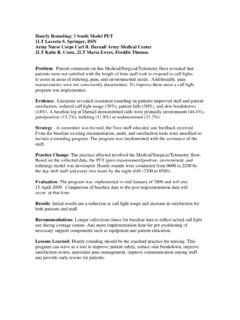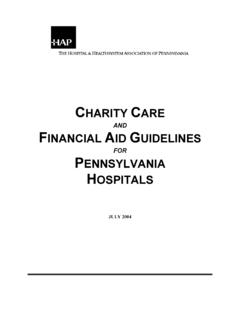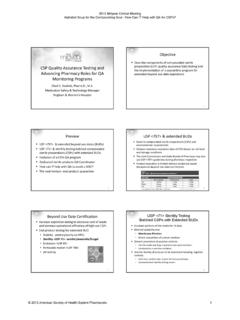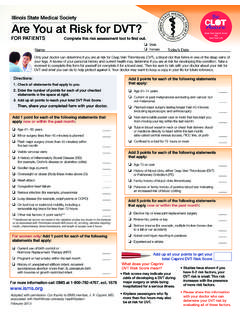Transcription of Evidence Based Practice Guidelines Related to …
1 Evidence Based Practice Guidelines Related to urinary Catheterization Ellen J. Angelo, RN, BSN, CCRN. Union Hospital Problem: urinary tract infections (UTIs) Related to over usage or inappropriate usage of urinary catheterization. Evidence : Hospital acquired UTIs are the leading cause of bacteremias and gram negative infections in the hospitalized patient. The duration of a catheter increases the patient's risk for acquiring a UTI. Catheterization should be limited to Evidence Based indicators such as neurogenic bladder, urinary retention and/or obstruction. Our program was Based on collaboration with the John A. Harford Foundation and New York University's NICHE (Nurses Improving Care for Healthsystem Elders) program. Strategy: Patients were assessed daily by the nurse using an approved validated and reliable audit tool.
2 Letters were placed on the medical record to the physician encouraging discontinue orders for those catheters not meeting the Evidence Based Guidelines . Practice Change: Catheters were discontinued as a result of auditing, evaluating, and determining appropriate usage. Anchoring devices were also implemented as a mechanism of preventing dislodgement/trauma from the catheter. Evaluation: 1. Number of catheter days. 2. Unit location of catheter insertion. 3. Compliance with an anchoring device. Data was collected using quantitative research via chart review and patient assessment in real time. Results: 1. 80% were inserted in the emergency department. 2. 16% were inserted for Evidence Based indicators. 3. Catheter days decreased from 510 to 196 days.
3 4. 80 catheters were discontinued within 48 hours of the physician letter. 5. Anchoring device compliance improved from 77% to 96%. 6. Total number of hospital acquired infections decreased from 36 in 2005 to 10 in 2006. The decrease in rates may be associated with a $17,576 cost saving Based on the benchmark of $ per UTI. Recommendations for 2007: 1. House wide- urinary catheter audits, staff education and physician letter application to all appropriate medical records. 2. Emergency room-Physician ordering screen to include a mandatory field for catheter indication. Lesson Learned: Increased education of the healthcare team to the Evidence has led to a decrease in catheter days and infection rates. Bibliography Gokula, R., Hickner, J.
4 , Smith, M. (2004). Inappropriate Use of urinary Catheters in Elderly Patients at a Midwestern Community Teaching Hospital. AJIC, 196-199. Goolsarran, V. & Katz, T. (2002). Do Not Go With the Flow, Remember Indwelling Catheters. JAGS, 50(10), 1739-1740. MacLennon, WJ. (2003). urinary Tract Infections in Older Patients. Clinical Gerontology, 13, 119-127. Mezey, M., Fulmer, T., Abraham, I. (2003). Geriatric Nursing Protocols for Best Practice . Springer Series on Geriatric Nursing. New York, NY. 83-95. Munasinghe, R., Habeeb, Y., Siddique, M., Hafeez, W. (2001). Appropriateness of Use Of Indwelling urinary Catheters in Patients Admitted to Medical Service. Infection Control and Hospital Epidemiology, 22(10). 647-649. Saint, S.
5 , Lipsky, B., Gold, S. (2002). Indwelling urinary Catheters: A One Point Restraint?. Annals of Internal Medicine, 137(2). 125-127.







